Acoustic Emission Monitoring of Carbon Fibre Reinforced Composites with Embedded Sensors for In-Situ Damage Identification
Abstract
:1. Introduction
2. Materials and Methods
2.1. Experimental Procedure
2.1.1. Manufacturing of Specimens
2.1.2. Measurement Procedure
2.2. Clustering Procedure
3. Results
3.1. Measuring AE with Embedded Sensors
3.1.1. Preliminary Testing
3.1.2. Embedded Sensor Performance during Four-Point Bending Experiments
3.1.3. Embedded Sensor Noise Mitigation during Four-Point Bending Experiments
3.2. Identification of Damage Mechanisms Occurring Due to the Embedding of a Piezoelectric Sensor
3.2.1. Visual Assessment of Damage Mechanisms
3.2.2. Assessment of Energy and Cumulative Energy
3.2.3. Identification of Damage Mechanisms Using Waveform Similarity
4. Discussion
4.1. Measuring AE with Embedded Sensors
4.2. Waveform Similarity Assessment for Identification of Noise and Damage Mechanisms
4.3. Identification of Damage Mechanisms Occurring Due to the Embedding of a Piezoelectric Sensor
4.4. Outlook and Future Research
5. Conclusions
- (1)
- The size of the embedded PWAS has an effect on the frequency content of the measurement of AE signals; Damage-related AE signals in CFRP specimens were measured with a centroid frequency between 350 kHz and 450 kHz by the 7 mm diameter embedded PWAS, while for the 20 mm embedded PWAS the range was between 200 kHz and 300 kHz. For comparison, no change in frequency content in the AE signals was measured by a reference surface-mounted sensor for the different specimens.
- (2)
- Damage mechanisms in the CFRP laminates due to embedded PWAS when placed in the tension side in the bending experiment exhibited AE that were reasonably distinguishable from other sources of AE. This was confirmed when assessing waveform similarity and AE energy in specimens with and without embedded sensors. When loaded under compression, no major additional degradation AE due to the embedment process was identified.
Author Contributions
Funding
Institutional Review Board Statement
Informed Consent Statement
Data Availability Statement
Acknowledgments
Conflicts of Interest
References
- Ruan, J.; Michael Ho, S.C.; Patil, D.; Li, M.; Song, G. Wind turbine blade damage detection using an active sensing approach. Smart Mater. Struct. 2014, 23. [Google Scholar] [CrossRef]
- Guo, Z.-S.; Zhang, J.; Hu, H.; Guo, X. Structural health monitoring of composite wind blades by fiber bragg grating. Int. Conf. Smart Mater. Nanotechnol. Eng. 2007, 6423, 64230I. [Google Scholar] [CrossRef]
- Yang, B.; Xuan, F.-Z.; Jin, P.; Hu, C.; Xiao, B.; Li, D.; Xiang, Y.; Lei, H. Damage Localization in Composite Laminates by Building in PZT Wafer Transducers: A Comparative Study with Surface-Bonded PZT Strategy. Adv. Eng. Mater. 2018, 21, 1801040. [Google Scholar] [CrossRef]
- Crawley, E.F.; De Luis, J. Use of piezoelectric actuators as elements of intelligent structures. AIAA J. 1987, 25, 1373–1385. [Google Scholar] [CrossRef]
- Tuloup, C.; Harizi, W.; Aboura, Z.; Meyer, Y. Structural health monitoring of polymer-matrix composite using embedded piezoelectric ceramic transducers during several four-points bending tests. Smart Mater. Struct. 2020, 29. [Google Scholar] [CrossRef]
- Shin, S.; Zamorano, B.; Elvin, N. Comparison of the electromechanical properties of embedded and surface-mounted piezoelectric transducers. J. Intell. Mater. Syst. Struct. 2016, 27, 2837–2850. [Google Scholar] [CrossRef]
- Erturk, A.; Inman, D.J. Piezoelectric Energy Harvesting; Wiley: Hoboken, NJ, USA, 2011; ISBN 9781119991359. [Google Scholar]
- Tzou, H.S.; Tseng, C.I. Distributed piezoelectric sensor/actuator design for dynamic measurement/control of distributed parameter systems: A piezoelectric finite element approach. J. Sound Vib. 1990, 138, 17–34. [Google Scholar] [CrossRef]
- Paget, C. Active Health Monitoring of Aerospace Composite Structures by Embedded Piezoceramic Transducers; Institutionen för flygteknik: Stockholm, Sweden, 2001. [Google Scholar]
- Andreades, C.; Mahmoodi, P.; Ciampa, F. Characterisation of smart CFRP composites with embedded PZT transducers for nonlinear ultrasonic applications. Compos. Struct. 2018, 206, 456–466. [Google Scholar] [CrossRef]
- Tang, H.Y.; Winkelmann, C.; Lestari, W.; La Saponara, V. Composite structural health monitoring through use of embedded PZT sensors. J. Intell. Mater. Syst. Struct. 2011, 22, 739–755. [Google Scholar] [CrossRef]
- Feng, T.; Bekas, D.; Aliabadi, M.H.F. Active Health Monitoring of Thick Composite Structures by Embedded and Surface-Mounted Piezo Diagnostic Layer. Sensors 2020, 20, 3410. [Google Scholar] [CrossRef]
- Ferri Aliabadi, M.H.; Khodaei, Z.S. Structural Health Monitoring for Advanced Composite Structures; World Scientific: Singapore, 2017; ISBN 9781786343932. [Google Scholar]
- Masmoudi, S.; El Mahi, A.; Turki, S.; El Guerjouma, R. Structural Health Monitoring of Smart Composite Material by Acoustic Emission. In Proceedings of the Acoustics 2012, Nantes, France, 23−27 April 2012. [Google Scholar]
- Dziendzikowski, M.; Niedbala, P.; Kurnyta, A.; Kowalczyk, K.; Dragan, K. Structural health monitoring of a composite panel based on PZT sensors and a transfer impedance framework. Sensors 2018, 18, 1521. [Google Scholar] [CrossRef] [Green Version]
- Lampani, L.; Sarasini, F.; Tirillò, J.; Gaudenzi, P. Analysis of damage in composite laminates with embedded piezoelectric patches subjected to bending action. Compos. Struct. 2018, 202, 935–942. [Google Scholar] [CrossRef]
- Dziendzikowski, M.; Kurnyta, A.; Dragan, K.; Klysz, S.; Leski, A. In situ Barely Visible Impact Damage detection and localization for composite structures using surface mounted and embedded PZT transducers: A comparative study. Mech. Syst. Signal Process. 2016, 78, 91–106. [Google Scholar] [CrossRef]
- Sause, M.G.R. In Situ Monitoring of Fiber-Reinforced Composites Theory, Basic Concepts, Methods, and Applications; Springer: Berlin/Heidelberg, Germany, 2016; ISBN 9783319309538. [Google Scholar]
- Kim, H.S.; Ghoshal, A.; Chattopadhyay, A.; Prosser, W.H. Development of embedded sensor models in composite laminates for structural health monitoring. J. Reinf. Plast. Compos. 2004, 23, 1207–1240. [Google Scholar] [CrossRef]
- Zappino, E.; Carrera, E. Advanced modeling of embedded piezo-electric transducers for the health-monitoring of layered structures. Int. J. Smart Nano Mater. 2020, 11, 325–342. [Google Scholar] [CrossRef]
- Nanda, N. Spectral finite element method for wave propagation analysis in smart composite beams containing delamination. Aircr. Eng. Aerosp. Technol. 2020, 92, 440–451. [Google Scholar] [CrossRef]
- Shukla, D.R.; Vizzini, A.J. Interlacing for improved performance of laminates with embedded devices. Smart Mater. Struct. 1996, 5, 225–229. [Google Scholar] [CrossRef]
- Lin, M.; Chang, F.-K. The manufacture of composite structures with a built-in network of piezoceramics. Compos. Sci. Technol. 2002, 62, 919–939. [Google Scholar] [CrossRef]
- Ghezzo, F.; Starr, A.F.; Smith, D.R. Integration of networks of sensors and electronics for structural health monitoring of composite materials. Adv. Civ. Eng. 2010, 2010. [Google Scholar] [CrossRef] [Green Version]
- Huang, Y.; Ghezzo, F.; Nemat-Nasser, S. Onset of resin micro-cracks in unidirectional glass fiber laminates with integrated SHM sensors: Numerical analysis. Struct. Heal. Monit. 2009, 8, 493–507. [Google Scholar] [CrossRef] [Green Version]
- Xiao, Y.; Qiao, W.; Fukuda, H.; Hatta, H. The effect of embedded devices on structural integrity of composite laminates. Compos. Struct. 2016, 153, 21–29. [Google Scholar] [CrossRef]
- Li, L.; Lomov, S.V.; Yan, X.; Carvelli, V. Cluster analysis of acoustic emission signals for 2D and 3D woven glass/epoxy composites. Compos. Struct. 2014, 116, 286–299. [Google Scholar] [CrossRef]
- Friedrich, L.; Colpo, A.; Maggi, A.; Becker, T.; Lacidogna, G.; Iturrioz, I. Damage process in glass fiber reinforced polymer specimens using acoustic emission technique with low frequency acquisition. Compos. Struct. 2021, 256, 113105. [Google Scholar] [CrossRef]
- Saeedifar, M.; Zarouchas, D. Damage characterization of laminated composites using acoustic emission: A review. Compos. Part B Eng. 2020, 195, 108039. [Google Scholar] [CrossRef]
- Kurz, J.H.; Finck, F.; Grosse, C.U.; Reinhardt, H. Similarity matrices as a new feature for acoustic emission analysis of concrete. In Proceedings of the 26th European Conference on Acoustic Emission Testing 2004, Berlin, Germany, 15–17 September 2004. [Google Scholar]
- Van Steen, C.; Pahlavan, L.; Wevers, M.; Verstrynge, E. Localisation and characterisation of corrosion damage in reinforced concrete by means of acoustic emission and X-ray computed tomography. Constr. Build. Mater. 2019, 197, 21–29. [Google Scholar] [CrossRef]
- van Steen, C. Clustering of acoustic emission signals for fracture monitoring during accelerated corrosion of reinforced concrete prisms. Mater. Sci. 2019. [Google Scholar] [CrossRef]
- Trugman, D.T.; Ross, Z.E.; Johnson, P.A. Imaging Stress and Faulting Complexity Through Earthquake Waveform Similarity. Geophys. Res. Lett. 2020, 47, 1–8. [Google Scholar] [CrossRef] [Green Version]
- Hexcel Composites Product data HexPly 8552. Hexcel 2000, 1, 1–6.
- Meggit Data for Modelling. Available online: https://www.meggittferroperm.com/resources/data-for-modelling/ (accessed on 10 April 2019).
- Huijer, A. Load And Damage Measurements on Fibre-Reinforced Composites with Embedded Piezoelectric Sensors. Master’s Thesis, Delft University of Technology, Delft, The Netherlands, 2019. [Google Scholar]
- Akaike, H. Markovian representation of stochastic processes and its application to the analysis of autoregressive moving average processes. Ann. Inst. Stat. Math. 1974, 26, 363–387. [Google Scholar] [CrossRef]
- Bai, F.; Gagar, D.; Foote, P.; Zhao, Y. Comparison of alternatives to amplitude thresholding for onset detection of acoustic emission signals. Mech. Syst. Signal Process. 2017, 84, 717–730. [Google Scholar] [CrossRef] [Green Version]
- Scheeren, B. On the Development of a Volumetric Acoustic Emission Fatigue Crack Monitoring System; Delft University of Technology: Delft, The Netherlands, 2017. [Google Scholar]
- MISTRAS R15I-AST Sensor. Available online: http://www.physicalacoustics.com/content/literature/sensors/Model_R15I-AST.pdf (accessed on 6 October 2021).
- Perls, T.A. Electrical noise from instrument cables subjected to shock and vibration. J. Appl. Phys. 1952, 23, 674–680. [Google Scholar] [CrossRef]









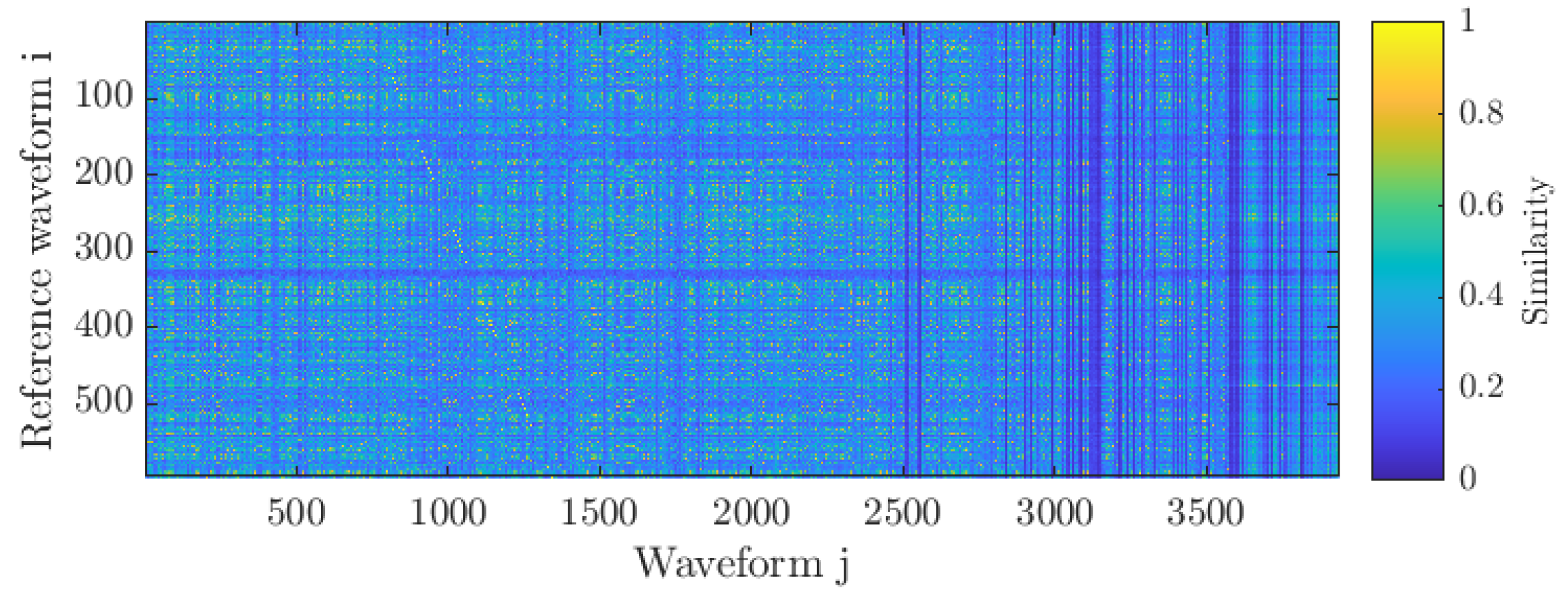

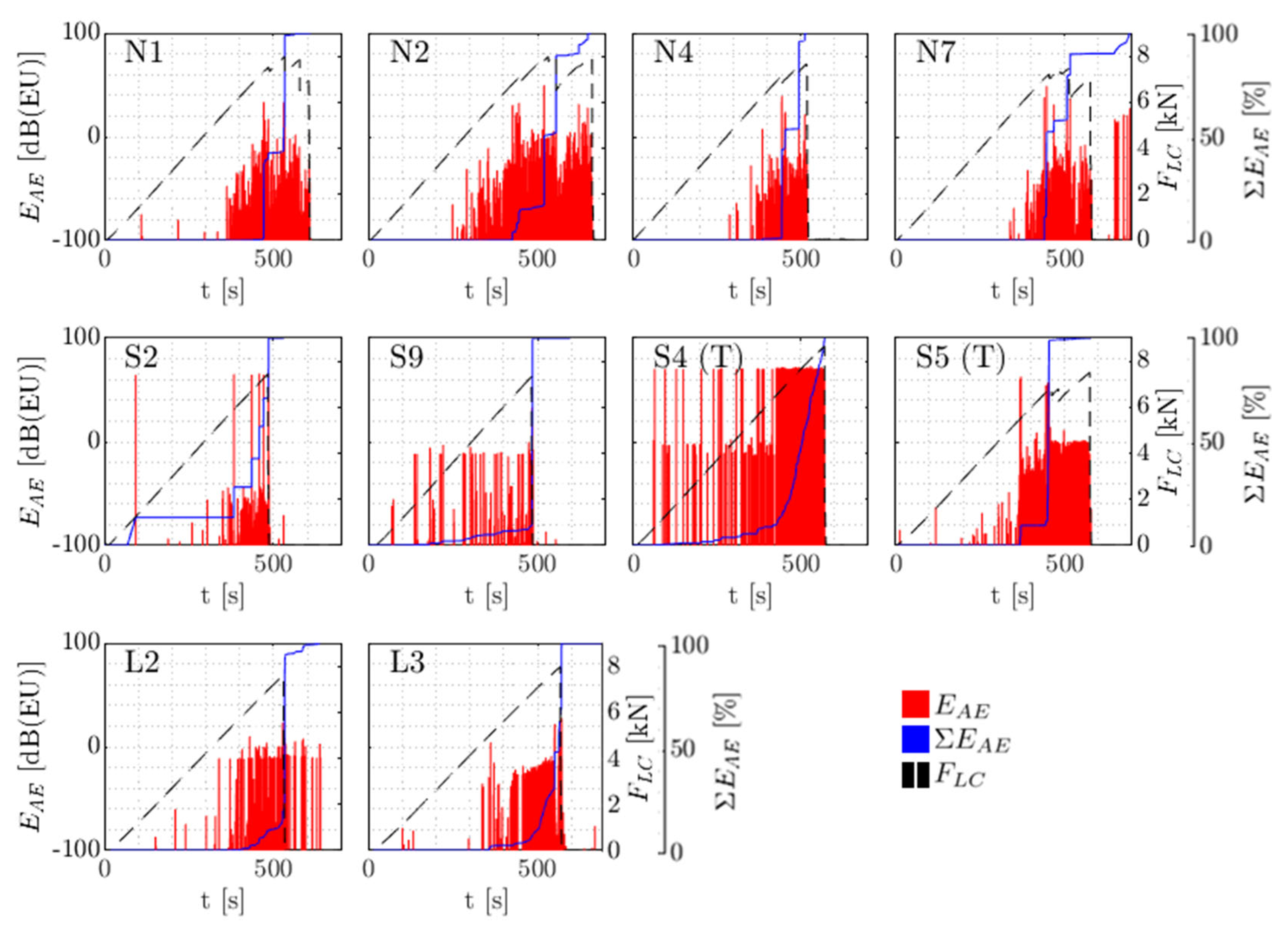

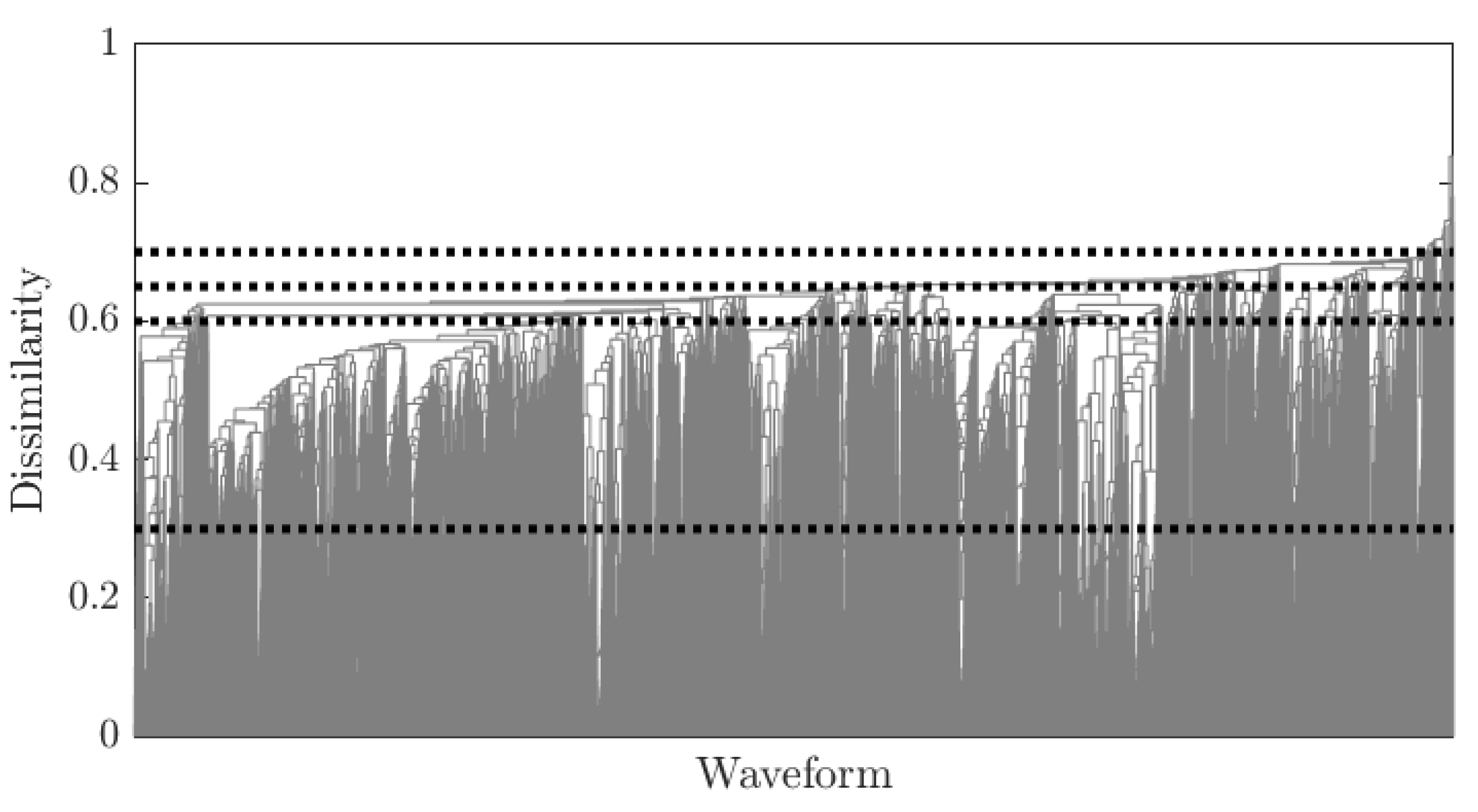
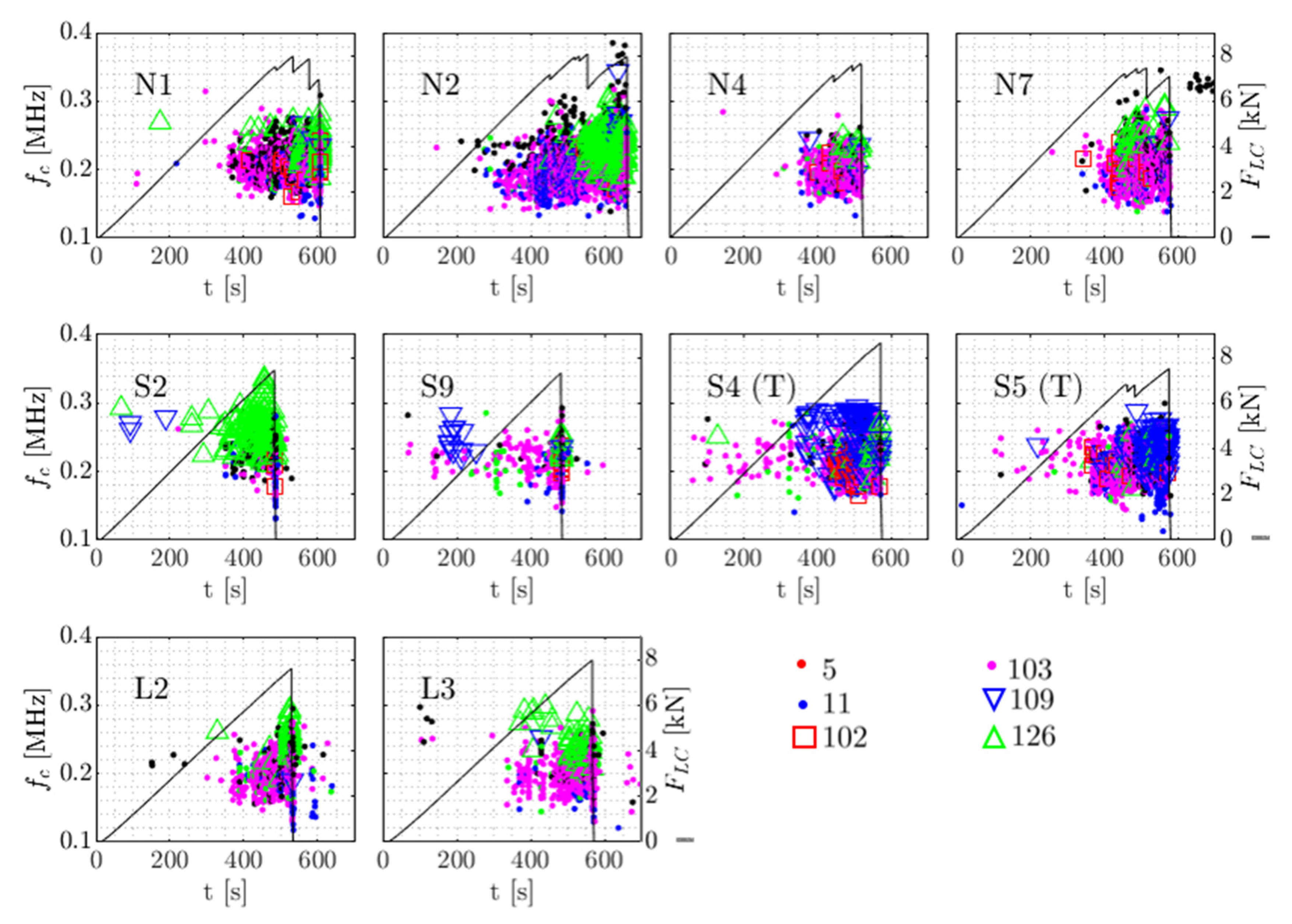

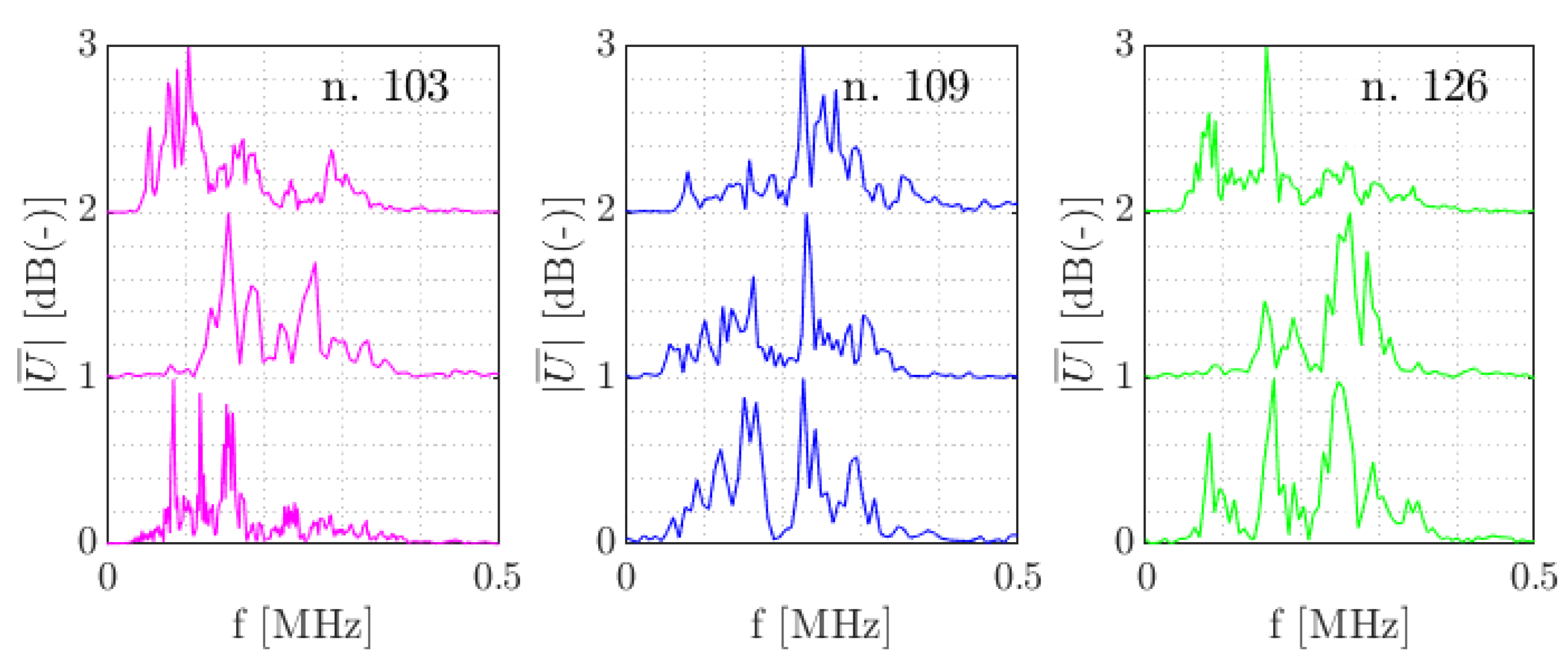
| Damage Mechanism | N | S | ST | L |
|---|---|---|---|---|
| Preliminary delamination on compressive side | v | v | v | v |
| Preliminary fibre breakage on compressive side | v | v | v | v |
| Extensive fibre breakage on compressive side | -/v | v | - | v |
| Extensive fibre breakage on tensile side | v | - | v | - |
| Sensor system failure on compressive side | - | v | - | v |
| Sensor system failure on tensile side | - | - | v | - |
| N | S | ST | L | |
|---|---|---|---|---|
| [EU] | 4.0 × 102 | 1.3 × 104 | 1.1 × 106 | 3.1 × 102 |
| 9.0 × 102 | 1.2 × 102 | 2.5 × 104 | 8.1 × 101 | |
| 3.5 × 102 | ||||
| 7.0 × 102 |
| Cluster Number | N [%] | S [%] | ST [%] | L [%] |
|---|---|---|---|---|
| 5 | 3 | 3 | 3 | 5 |
| 11 | 19 | 12 | 13 | 8 |
| 21 | 2 | 0 | 3 | 1 |
| 102 | 0 | 1 | 4 | 0 |
| 103 | 61 | 37 | 53 | 70 |
| 104 | 3 | 4 | 0 | 1 |
| 109 | 0 | 1 | 12 | 0 |
| 126 | 4 | 19 | 1 | 6 |
| Total | 92 | 77 | 89 | 91 |
Publisher’s Note: MDPI stays neutral with regard to jurisdictional claims in published maps and institutional affiliations. |
© 2021 by the authors. Licensee MDPI, Basel, Switzerland. This article is an open access article distributed under the terms and conditions of the Creative Commons Attribution (CC BY) license (https://creativecommons.org/licenses/by/4.0/).
Share and Cite
Huijer, A.; Kassapoglou, C.; Pahlavan, L. Acoustic Emission Monitoring of Carbon Fibre Reinforced Composites with Embedded Sensors for In-Situ Damage Identification. Sensors 2021, 21, 6926. https://doi.org/10.3390/s21206926
Huijer A, Kassapoglou C, Pahlavan L. Acoustic Emission Monitoring of Carbon Fibre Reinforced Composites with Embedded Sensors for In-Situ Damage Identification. Sensors. 2021; 21(20):6926. https://doi.org/10.3390/s21206926
Chicago/Turabian StyleHuijer, Arnaud, Christos Kassapoglou, and Lotfollah Pahlavan. 2021. "Acoustic Emission Monitoring of Carbon Fibre Reinforced Composites with Embedded Sensors for In-Situ Damage Identification" Sensors 21, no. 20: 6926. https://doi.org/10.3390/s21206926






